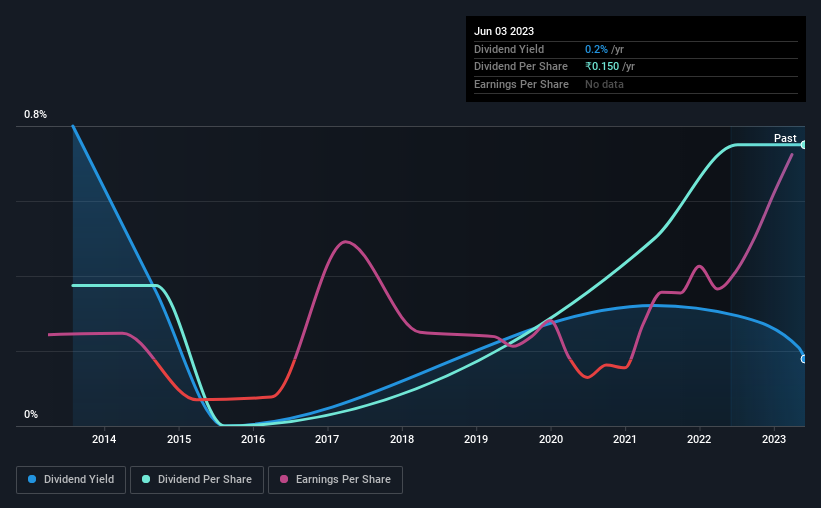- India
- /
- Electrical
- /
- NSEI:TARIL
Transformers and Rectifiers (India) (NSE:TRIL) Is Paying Out A Dividend Of ₹0.15
Transformers and Rectifiers (India) Limited (NSE:TRIL) has announced that it will pay a dividend of ₹0.15 per share on the 30th of August. This means the annual payment will be 0.2% of the current stock price, which is lower than the industry average.
While the dividend yield is important for income investors, it is also important to consider any large share price moves, as this will generally outweigh any gains from distributions. Investors will be pleased to see that Transformers and Rectifiers (India)'s stock price has increased by 39% in the last 3 months, which is good for shareholders and can also explain a decrease in the dividend yield.
Check out our latest analysis for Transformers and Rectifiers (India)
Transformers and Rectifiers (India)'s Earnings Easily Cover The Distributions
The dividend yield is a little bit low, but sustainability of the payments is also an important part of evaluating an income stock. However, prior to this announcement, Transformers and Rectifiers (India)'s dividend was comfortably covered by both cash flow and earnings. This means that most of what the business earns is being used to help it grow.
If the trend of the last few years continues, EPS will grow by 49.8% over the next 12 months. If the dividend continues along recent trends, we estimate the payout ratio will be 3.5%, which is in the range that makes us comfortable with the sustainability of the dividend.

Dividend Volatility
While the company has been paying a dividend for a long time, it has cut the dividend at least once in the last 10 years. The dividend has gone from an annual total of ₹0.075 in 2013 to the most recent total annual payment of ₹0.15. This works out to be a compound annual growth rate (CAGR) of approximately 7.2% a year over that time. A reasonable rate of dividend growth is good to see, but we're wary that the dividend history is not as solid as we'd like, having been cut at least once.
The Dividend Looks Likely To Grow
Given that the dividend has been cut in the past, we need to check if earnings are growing and if that might lead to stronger dividends in the future. It's encouraging to see that Transformers and Rectifiers (India) has been growing its earnings per share at 50% a year over the past five years. Earnings per share is growing at a solid clip, and the payout ratio is low which we think is an ideal combination in a dividend stock as the company can quite easily raise the dividend in the future.
Transformers and Rectifiers (India) Looks Like A Great Dividend Stock
Overall, we like to see the dividend staying consistent, and we think Transformers and Rectifiers (India) might even raise payments in the future. Distributions are quite easily covered by earnings, which are also being converted to cash flows. Taking this all into consideration, this looks like it could be a good dividend opportunity.
Companies possessing a stable dividend policy will likely enjoy greater investor interest than those suffering from a more inconsistent approach. Meanwhile, despite the importance of dividend payments, they are not the only factors our readers should know when assessing a company. For example, we've picked out 1 warning sign for Transformers and Rectifiers (India) that investors should know about before committing capital to this stock. Looking for more high-yielding dividend ideas? Try our collection of strong dividend payers.
Valuation is complex, but we're here to simplify it.
Discover if Transformers and Rectifiers (India) might be undervalued or overvalued with our detailed analysis, featuring fair value estimates, potential risks, dividends, insider trades, and its financial condition.
Access Free AnalysisHave feedback on this article? Concerned about the content? Get in touch with us directly. Alternatively, email editorial-team (at) simplywallst.com.
This article by Simply Wall St is general in nature. We provide commentary based on historical data and analyst forecasts only using an unbiased methodology and our articles are not intended to be financial advice. It does not constitute a recommendation to buy or sell any stock, and does not take account of your objectives, or your financial situation. We aim to bring you long-term focused analysis driven by fundamental data. Note that our analysis may not factor in the latest price-sensitive company announcements or qualitative material. Simply Wall St has no position in any stocks mentioned.
About NSEI:TARIL
Transformers and Rectifiers (India)
Manufactures and sells transformers in India.
Exceptional growth potential with flawless balance sheet.
Market Insights
Community Narratives




